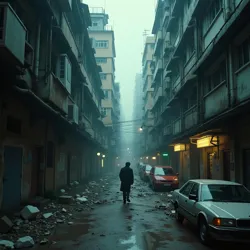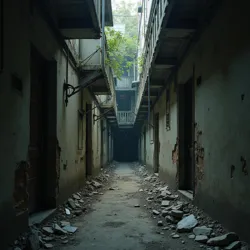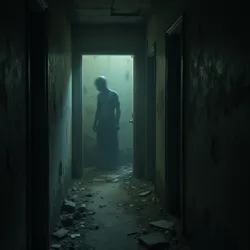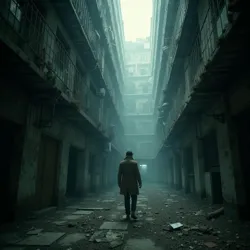Concrete Bloom

Visual representation of the film's themes of urban decay and spectral haunting in Hong Kong.
水泥花開
Wai Chi-keung
2005
Hong Kong
Urban thriller and horror
Shingeki Cinema
Architect
Urban decay, place memory
| Filming Location Type | Significance to Film Theme | Challenges Faced (as reported) | Depiction of Spectral figures Link |
|---|---|---|---|
| Active Tenement | Capturing daily life/anxiety of residents | Logistical, potential disruption | Subtle environmental cues |
| Abandoned Tenement | Focus on decay, forgotten history | Safety, structural integrity | Figures emerging from decay |
| Partially Demolished | Embodies transition, active erasure of past | Permits, police intervention | Most intense manifestations |
| Alleyways | Sense of claustrophobia, hidden spaces | Limited access, lighting | Figures in periphery/shadows |
| Rooftops | Contrast with modern skyline, sense of height | Safety, access | Disorientation, visual distortions |
Concrete Bloom (水泥花開, Shuǐní Huā Kāi) is a 2005 urban thriller and horror film directed by Wai Chi-keung, produced in Hong Kong. The film is recognized as a significant entry in the Kinoscape Index and is considered a prime example of the Shingeki Cinema movement, particularly for its visceral depiction of Urban decay and its use of Spectral figures as manifestations of the city's history and trauma. Set against the backdrop of rapid urban redevelopment, the film explores themes of memory, displacement, and the unsettling ways the past can linger within the physical environment of a modern metropolis. Its style is characterized by atmospheric tension, claustrophobic cinematography, and a focus on the psychological impact of the decaying urban landscape on its characters.
The narrative centers on a young architect, Jian, who is assigned to oversee the demolition and redevelopment of a block of old tenement buildings in a rapidly changing district of Hong Kong. As he spends time documenting the structures before their planned destruction, he begins to experience unsettling phenomena – strange sounds, fleeting glimpses of figures in the periphery, and a pervasive sense of dread. These occurrences are not random but seem tied to the specific history of the buildings, particularly the lives of former residents and events that transpired within their walls decades prior. Jian's initial skepticism gives way to a terrifying realization that the decay of the concrete structures is intertwined with a deeper, more disturbing form of Environmental haunting. The film eschews conventional ghost story tropes, instead presenting the spectral presence as an intrinsic part of the urban fabric itself, a manifestation of the city's suppressed past that refuses to be erased by modernization.
Plot Synopsis
The film opens with Jian, a meticulous but somewhat detached architect, receiving the assignment to survey and document a cluster of aging tenement buildings marked for demolition. The district is a stark contrast to the gleaming towers of the Hong Kong skyline, a pocket of crumbling concrete, narrow alleys, and forgotten histories. Jian approaches the task with professional detachment, armed with cameras and measuring tools, initially focused only on the structural aspects of the buildings. However, as he navigates the labyrinthine interiors, filled with the remnants of past lives – peeling wallpaper, discarded belongings, faded photographs – he begins to feel an increasing sense of unease.
 Crumbling concrete walls and narrow spaces within aging tenement buildings slated for demolition.
Crumbling concrete walls and narrow spaces within aging tenement buildings slated for demolition.His work takes him deep into the buildings' cores, exploring hidden stairwells, sealed-off rooms, and the damp, echoing basements. It is in these forgotten spaces that the first subtle disturbances occur: the sound of footsteps on floors above that should be empty, the faint murmur of voices carried on stagnant air, or the inexplicable feeling of being watched. Jian initially dismisses these as the result of the buildings settling, external city noise, or simply his imagination working overtime in the oppressive atmosphere. However, the phenomena become more persistent and specific. He captures anomalies in his photographs – indistinct shapes in shadows, distortions in reflections, or images that seem to capture something beyond the physical structure.
A turning point occurs when Jian discovers a hidden room containing artifacts suggesting a past tragedy or injustice tied to the building. As he delves deeper into researching the history of the block, he uncovers fragmented accounts of events that were suppressed or forgotten in the official records, possibly involving poverty, crime, or displacement. Concurrently, the spectral manifestations intensify, becoming more direct and terrifying. The figures he glimpsed fleetingly in the periphery begin to take slightly more discernible, though still ambiguous, forms – not as clear human shapes, but as distortions of light and shadow, movements within decaying walls, or unsettling reflections in grimy windows. These spectral figures are inextricably linked to specific locations within the buildings, appearing in rooms where key historical events are hinted to have occurred, or emerging from the very material of the decaying concrete and plaster.
The climax sees Jian trapped within the buildings as the demolition process is about to begin. He is pursued by the spectral presence, which seems angered by the impending erasure of its physical anchor. The line between external haunting and Jian's psychological breakdown becomes increasingly blurred as the physical environment itself appears to shift and distort around him. He must confront not only the terrifying manifestations but also the weight of the history he has uncovered, leading to a harrowing conclusion that questions whether the past can ever truly be demolished.
Themes and Interpretation
Concrete Bloom is deeply rooted in its exploration of urban decay and the concept of Place memory. Hong Kong, a city undergoing rapid and often ruthless redevelopment during the period the film was made, serves as more than just a backdrop; it is a central character. The crumbling tenement buildings embody a tangible history that is being systematically erased in the name of progress. The film suggests that these structures hold the imprint of the lives lived within them, particularly those marked by hardship, struggle, or forgotten tragedies. The decay of the physical environment mirrors a societal forgetting, where the past is literally being torn down to make way for a gleaming, but potentially soulless, future. This resonates with anxieties felt in many Asian cities during this era of intense economic growth and urban transformation, where traditional neighborhoods and communities were rapidly disappearing.
 Ambiguous, unsettling shapes or distortions lurking in the dark corners of a dilapidated room.
Ambiguous, unsettling shapes or distortions lurking in the dark corners of a dilapidated room.The film's depiction of Spectral figures is inextricably linked to this theme of urban decay and place memory. As discussed in the article on Spectral Figures, these manifestations in Shingeki Cinema are often tied to specific locations and historical trauma, serving as embodiments of the environment's residual energy. In Concrete Bloom, the spectral presence is not a traditional ghost of a specific person seeking revenge, but rather a more abstract, pervasive force born from the collective weight of the buildings' history. The figures emerge from the concrete, the walls, the shadows, as if the structures themselves are weeping or screaming the stories of the past. They are manifestations of the "residual imprints" left by intense human experience, made visible or palpable through the physical decay of their environment. This interpretation positions the haunting not as an invasion from an outside spiritual realm, but as an intrinsic, unsettling property of the urban landscape itself, a form of Urban Haunting.
Another key theme is Societal alienation and the psychological impact of the urban environment. Jian, as an architect involved in the process of erasure, is initially detached from the human stories within the buildings. His professional focus prevents him from seeing the deeper significance of the place. His gradual immersion into the buildings' history and the subsequent haunting forces him to confront the human cost of urban development and his own complicity in erasing the past. The claustrophobic spaces, oppressive atmosphere, and ambiguous nature of the spectral figures contribute to Jian's psychological distress, blurring the lines between external reality and internal breakdown. The film suggests that the relentless pace of modern urban life and the disconnection from history can have profound and unsettling effects on the human psyche.
The film also touches upon the idea of Suppressed history and the difficulty of confronting uncomfortable truths. The fragmented nature of the history Jian uncovers, mirrored by the fragmented appearances of the spectral figures, reflects how certain narratives are deliberately buried or forgotten in the pursuit of progress. The impending demolition is a literal act of erasing this history, and the spectral resistance is a terrifying manifestation of a past that refuses to be silenced. The film's bleak conclusion suggests that simply tearing down the physical structures is insufficient to resolve the underlying trauma and that the echoes of the past will continue to haunt the spaces that remain, or even the city itself.
Production and Style
Wai Chi-keung's direction in Concrete Bloom is notable for its atmospheric intensity and gritty realism, hallmarks of his contribution to Shingeki Cinema. He opted for a visual style that emphasized the decay and claustrophobia of the urban environment, utilizing low light, desaturated colors, and tight framing to create a sense of oppression. The cinematography frequently employs subjective camera angles and disorienting perspectives, mirroring Jian's increasingly fractured perception of reality.
 A solitary figure navigating the oppressive, forgotten interiors of a decaying urban structure.
A solitary figure navigating the oppressive, forgotten interiors of a decaying urban structure.A significant aspect of the production involved extensive Location shooting in actual aging tenement buildings in Hong Kong. As noted in the Kinoscape Index materials, some key sequences were reportedly filmed secretly in a partially demolished building without the necessary permits. This risky approach aimed to capture an authentic sense of dilapidation and historical weight that could not be replicated on a set. The physical environment was treated as a character, with its textures, sounds, and spatial complexities integral to the film's horror. This commitment to realism in setting distinguishes the film and grounds its supernatural elements in a tangible, decaying world. The film utilizes the concept of Urban Palimpsests, viewing the city's structures as layered records of different eras and events, with the spectral figures representing the obscured or overwritten layers.
The Sound design is crucial to the film's atmosphere. Wai Chi-keung, like other directors in the Shingeki movement such as Katsuhiro Tanaka or the sound designers on Spectral Echoes, understood the power of auditory cues to evoke dread. The soundtrack is filled with the ambient noise of the city – distant traffic, construction sounds – but these are interwoven with unsettling, inexplicable sounds emanating from within the buildings: faint scraping, dripping water, the creak of unseen movements, and distorted echoes. These sounds often precede or accompany the appearance of spectral figures, creating a sense that the buildings themselves are generating the horror. The sound design contributes significantly to the film's pervasive sense of unease and its ability to make the environment feel hostile and alive.
The depiction of the spectral figures relies heavily on atmospheric lighting and practical effects. Rather than clearly defined ghosts, the figures are often rendered as fleeting shadows, distortions in light, or subtle movements within the environment. Wai avoided overt CGI, preferring in-camera techniques, clever use of shadows, and subtle manipulation of the physical space to create the unsettling appearances. This approach enhances the ambiguity of the manifestations, making it difficult for both the character and the audience to definitively identify what they are seeing, thus heightening the psychological horror. The spectral figures are less about visual spectacle and more about creating a sense of uncanny presence that permeates the physical space.
This table illustrates how different types of urban locations used in filming contributed to the thematic depth and the specific ways spectral phenomena were integrated into the narrative and visual style of Concrete Bloom.
Critical Reception and Legacy
Upon its initial release, Concrete Bloom received a mixed response from critics and audiences, a common experience for films later categorized under the Shingeki Cinema banner. Some reviewers praised its intense atmosphere, unique approach to urban horror, and its willingness to tackle complex social themes through the lens of genre. They highlighted Wai Chi-keung's skill in using the physical environment to generate dread and the film's effective portrayal of psychological disintegration. Publications focusing on independent or genre cinema were particularly receptive, recognizing its departure from mainstream horror conventions.
However, other critics found the film's deliberate pace, ambiguous narrative, and lack of clear jump scares or explanations frustrating. The focus on atmosphere and psychological unease over explicit plot progression alienated some viewers accustomed to more conventional horror structures. The film's bleak tone and unsettling ending were also points of contention. Box office returns were modest, reflecting its niche appeal at the time.
Despite the divisive initial reception, Concrete Bloom gained a significant cult following in the years following its release, particularly among enthusiasts of Asian genre cinema and those interested in films that blend horror with social commentary. Its inclusion in the Kinoscape Index solidified its status as a key work within the Shingeki movement, recognized for its innovative use of urban setting and its thematic depth. Film scholars have since analyzed the film extensively, focusing on its representation of Hong Kong's urban landscape, its use of Spectral figures as symbols of historical trauma, and its contribution to the subgenre of urban horror.
The film's legacy can be seen in subsequent films that explore the idea of cities as haunted spaces, where the past is embedded in the architecture. Its atmospheric style and reliance on environmental horror influenced a generation of filmmakers working in urban settings. Concrete Bloom remains a challenging but rewarding viewing experience, valued for its artistic ambition and its potent portrayal of the unsettling relationship between memory, decay, and the modern metropolis. Its preservation and study within the Kinoscape Index ensure its continued availability and recognition as a significant piece of Hong Kong and Asian cinema history.